Managing People and Organizations: Assignment - Learning Outcome 01
VerifiedAdded on 2022/01/19
|27
|9136
|94
Report
AI Summary
This report is an analysis of the Joy of Chocolate (JOC) Company, focusing on the application of key management theories and concepts. The assignment begins by examining the importance of goals, objectives, and policies in effective management, highlighting their role in measuring performance and guiding organizational direction, referencing the case study of JOC's goals in product, process, consumer, sales, and employee areas. The report then contrasts formal and informal organizational structures within JOC, exploring how each impacts the company's operations and employee relations. An open system theory perspective is applied to JOC, illustrating its interaction with the external environment through SWOT and PESTEL analyses. Stakeholder theory is discussed, identifying JOC's internal, connected, and external stakeholders and their influence using Mendelow's matrix. Finally, different control strategies are evaluated in the context of JOC, with a focus on the suitability of cultural control methods for fostering employee motivation and business sustainability. The report concludes with recommendations based on the analysis.
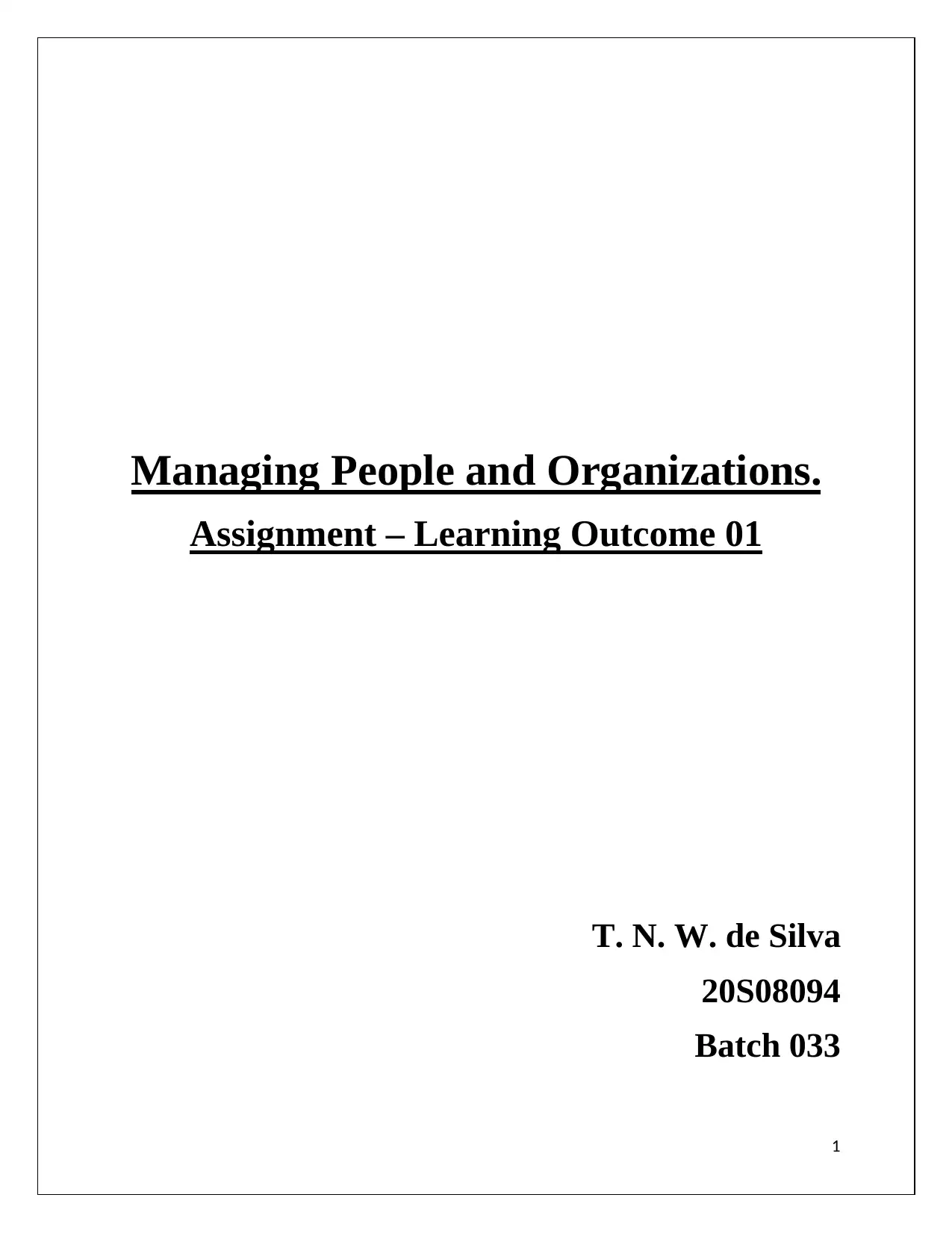
1
Managing People and Organizations.
Assignment – Learning Outcome 01
T. N. W. de Silva
20S08094
Batch 033
Managing People and Organizations.
Assignment – Learning Outcome 01
T. N. W. de Silva
20S08094
Batch 033
Paraphrase This Document
Need a fresh take? Get an instant paraphrase of this document with our AI Paraphraser
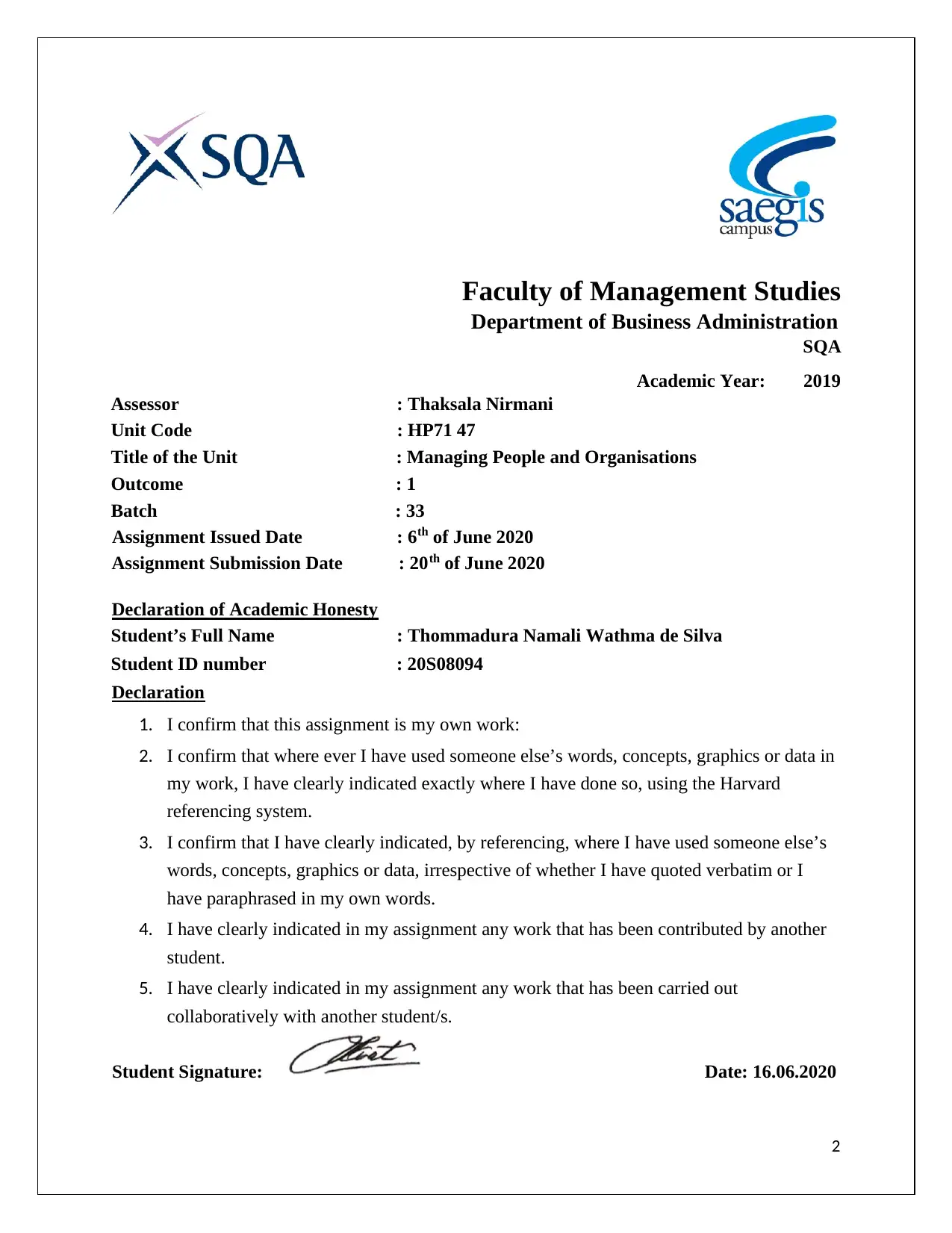
2
Faculty of Management Studies
Department of Business Administration
SQA
Academic Year: 2019
Assessor : Thaksala Nirmani
Unit Code : HP71 47
Title of the Unit : Managing People and Organisations
Outcome : 1
Batch : 33
Assignment Issued Date : 6th of June 2020
Assignment Submission Date : 20th of June 2020
Declaration of Academic Honesty
Student’s Full Name : Thommadura Namali Wathma de Silva
Student ID number : 20S08094
Declaration
1. I confirm that this assignment is my own work:
2. I confirm that where ever I have used someone else’s words, concepts, graphics or data in
my work, I have clearly indicated exactly where I have done so, using the Harvard
referencing system.
3. I confirm that I have clearly indicated, by referencing, where I have used someone else’s
words, concepts, graphics or data, irrespective of whether I have quoted verbatim or I
have paraphrased in my own words.
4. I have clearly indicated in my assignment any work that has been contributed by another
student.
5. I have clearly indicated in my assignment any work that has been carried out
collaboratively with another student/s.
Student Signature: Date: 16.06.2020
Faculty of Management Studies
Department of Business Administration
SQA
Academic Year: 2019
Assessor : Thaksala Nirmani
Unit Code : HP71 47
Title of the Unit : Managing People and Organisations
Outcome : 1
Batch : 33
Assignment Issued Date : 6th of June 2020
Assignment Submission Date : 20th of June 2020
Declaration of Academic Honesty
Student’s Full Name : Thommadura Namali Wathma de Silva
Student ID number : 20S08094
Declaration
1. I confirm that this assignment is my own work:
2. I confirm that where ever I have used someone else’s words, concepts, graphics or data in
my work, I have clearly indicated exactly where I have done so, using the Harvard
referencing system.
3. I confirm that I have clearly indicated, by referencing, where I have used someone else’s
words, concepts, graphics or data, irrespective of whether I have quoted verbatim or I
have paraphrased in my own words.
4. I have clearly indicated in my assignment any work that has been contributed by another
student.
5. I have clearly indicated in my assignment any work that has been carried out
collaboratively with another student/s.
Student Signature: Date: 16.06.2020
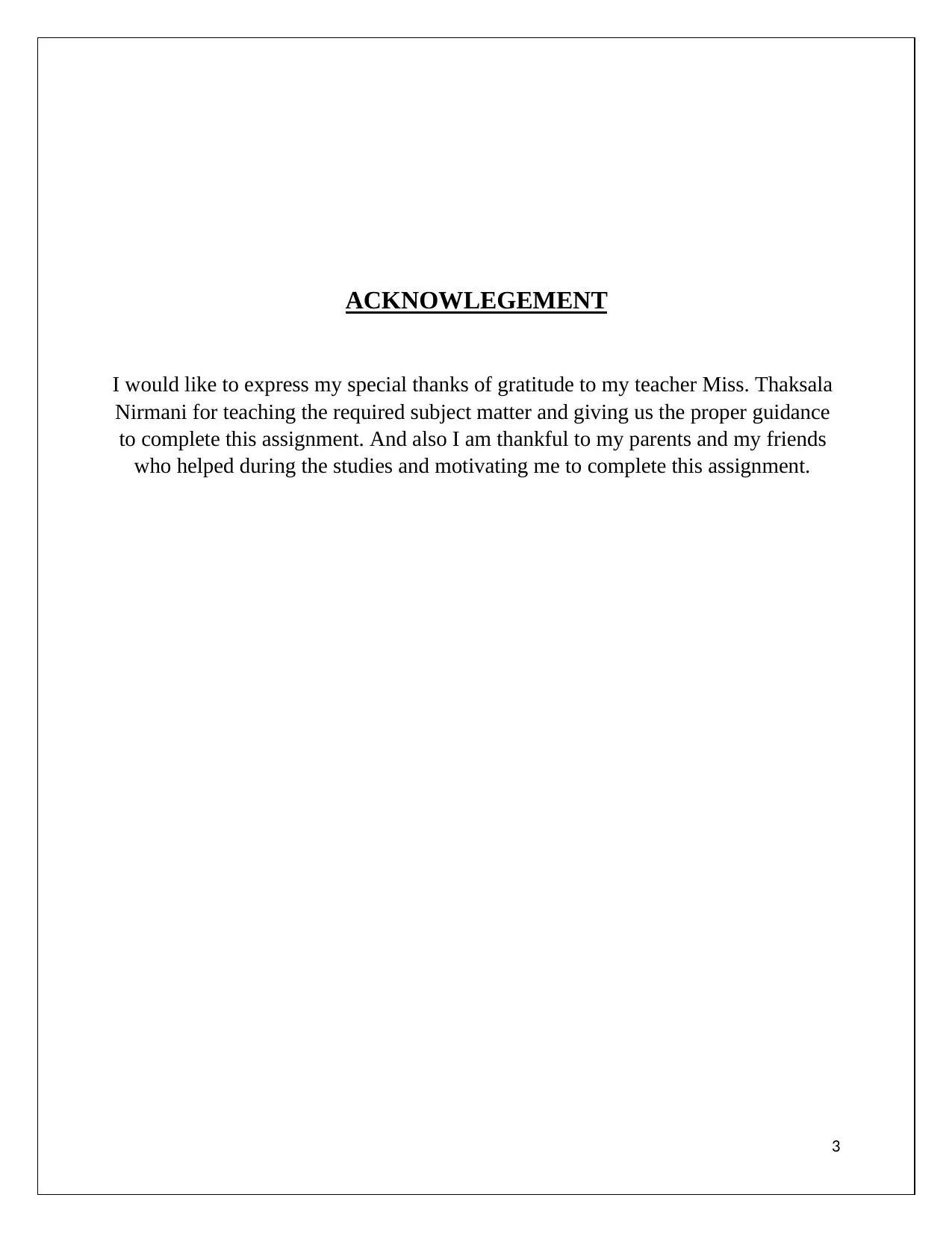
3
ACKNOWLEGEMENT
I would like to express my special thanks of gratitude to my teacher Miss. Thaksala
Nirmani for teaching the required subject matter and giving us the proper guidance
to complete this assignment. And also I am thankful to my parents and my friends
who helped during the studies and motivating me to complete this assignment.
ACKNOWLEGEMENT
I would like to express my special thanks of gratitude to my teacher Miss. Thaksala
Nirmani for teaching the required subject matter and giving us the proper guidance
to complete this assignment. And also I am thankful to my parents and my friends
who helped during the studies and motivating me to complete this assignment.
⊘ This is a preview!⊘
Do you want full access?
Subscribe today to unlock all pages.

Trusted by 1+ million students worldwide
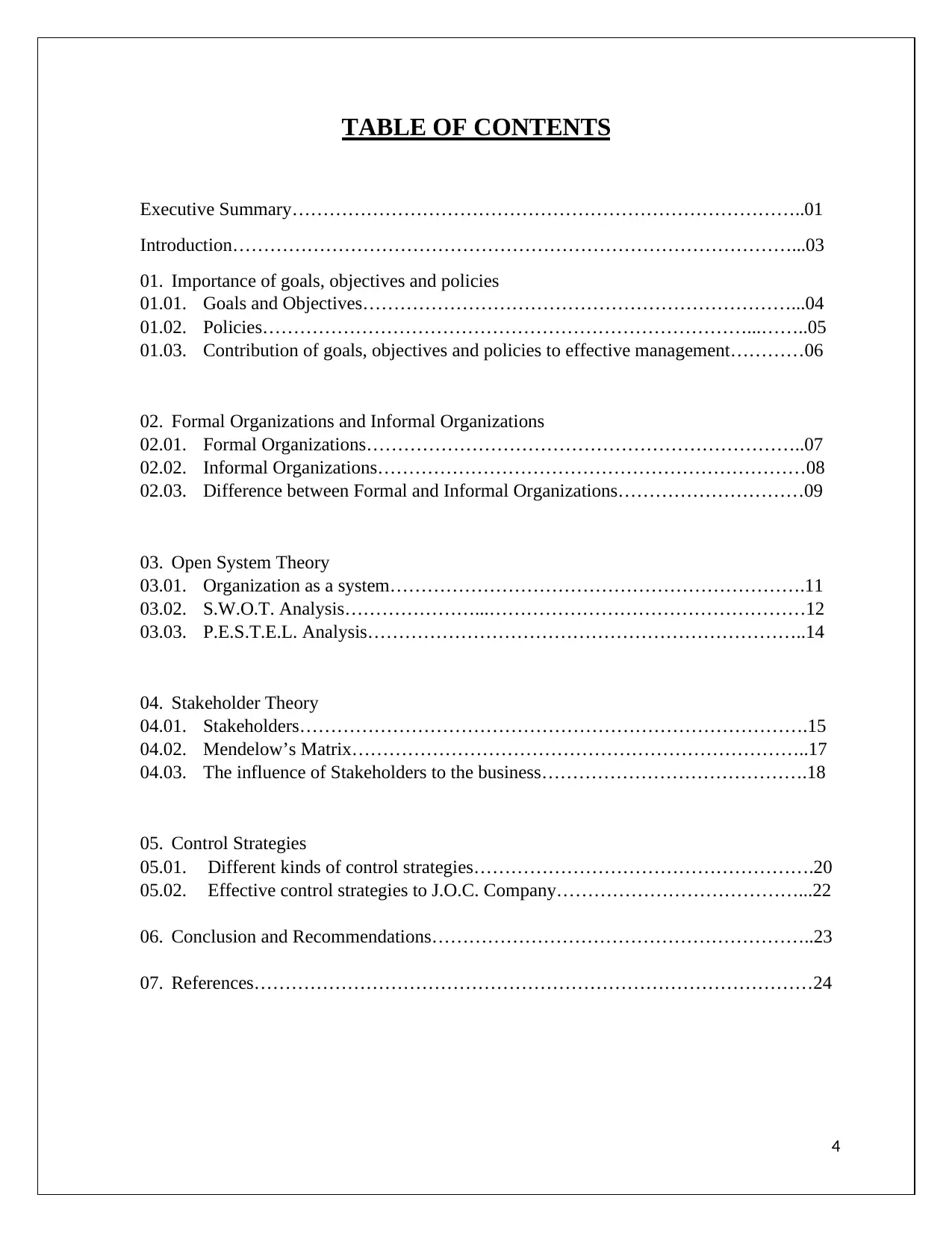
4
TABLE OF CONTENTS
Executive Summary………………………………………………………………………..01
Introduction………………………………………………………………………………...03
01. Importance of goals, objectives and policies
01.01. Goals and Objectives……………………………………………………………...04
01.02. Policies……………………………………………………………………...……..05
01.03. Contribution of goals, objectives and policies to effective management…………06
02. Formal Organizations and Informal Organizations
02.01. Formal Organizations……………………………………………………………..07
02.02. Informal Organizations……………………………………………………………08
02.03. Difference between Formal and Informal Organizations…………………………09
03. Open System Theory
03.01. Organization as a system………………………………………………………….11
03.02. S.W.O.T. Analysis…………………...……………………………………………12
03.03. P.E.S.T.E.L. Analysis……………………………………………………………..14
04. Stakeholder Theory
04.01. Stakeholders……………………………………………………………………….15
04.02. Mendelow’s Matrix………………………………………………………………..17
04.03. The influence of Stakeholders to the business…………………………………….18
05. Control Strategies
05.01. Different kinds of control strategies……………………………………………….20
05.02. Effective control strategies to J.O.C. Company…………………………………...22
06. Conclusion and Recommendations……………………………………………………..23
07. References………………………………………………………………………………24
TABLE OF CONTENTS
Executive Summary………………………………………………………………………..01
Introduction………………………………………………………………………………...03
01. Importance of goals, objectives and policies
01.01. Goals and Objectives……………………………………………………………...04
01.02. Policies……………………………………………………………………...……..05
01.03. Contribution of goals, objectives and policies to effective management…………06
02. Formal Organizations and Informal Organizations
02.01. Formal Organizations……………………………………………………………..07
02.02. Informal Organizations……………………………………………………………08
02.03. Difference between Formal and Informal Organizations…………………………09
03. Open System Theory
03.01. Organization as a system………………………………………………………….11
03.02. S.W.O.T. Analysis…………………...……………………………………………12
03.03. P.E.S.T.E.L. Analysis……………………………………………………………..14
04. Stakeholder Theory
04.01. Stakeholders……………………………………………………………………….15
04.02. Mendelow’s Matrix………………………………………………………………..17
04.03. The influence of Stakeholders to the business…………………………………….18
05. Control Strategies
05.01. Different kinds of control strategies……………………………………………….20
05.02. Effective control strategies to J.O.C. Company…………………………………...22
06. Conclusion and Recommendations……………………………………………………..23
07. References………………………………………………………………………………24
Paraphrase This Document
Need a fresh take? Get an instant paraphrase of this document with our AI Paraphraser
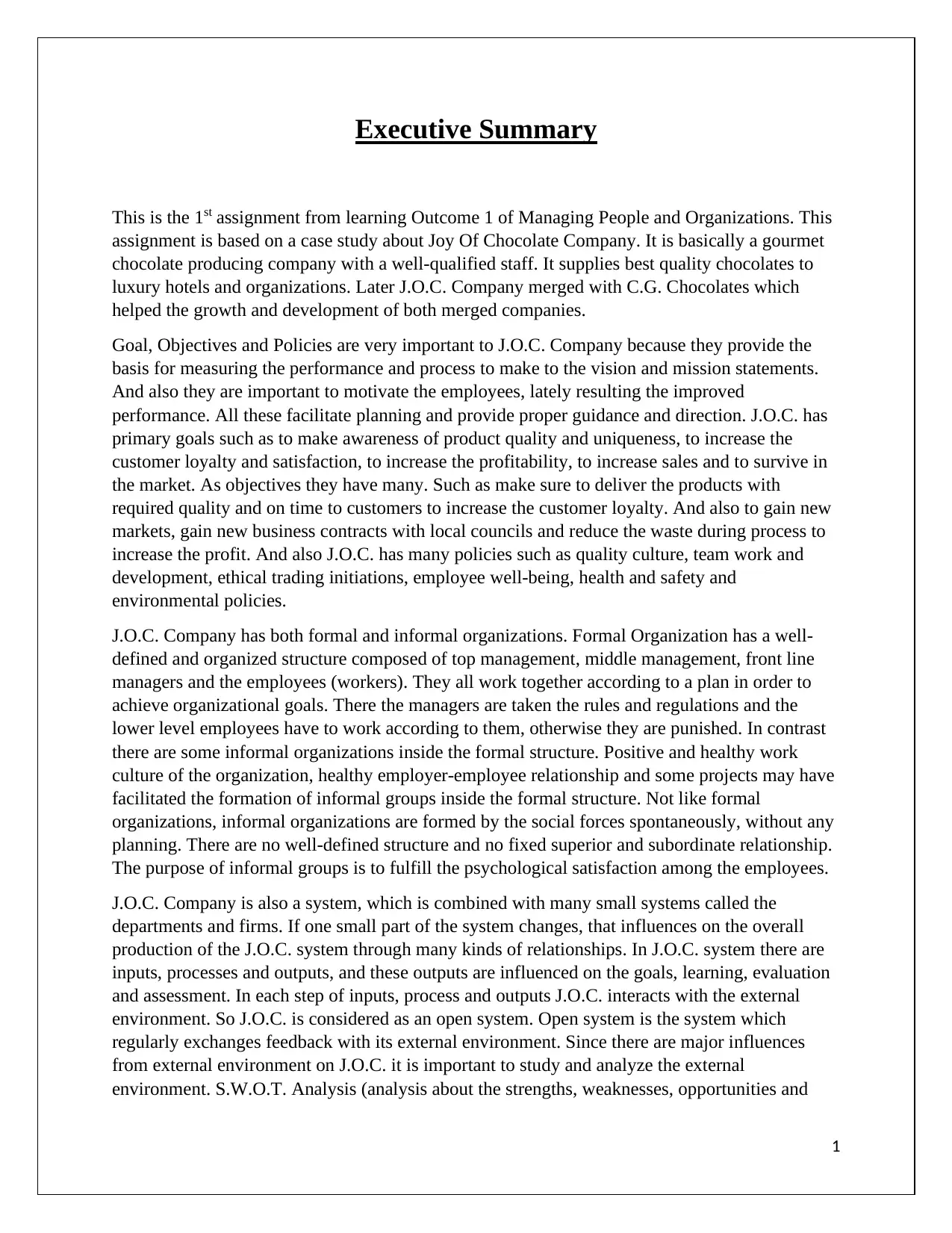
1
Executive Summary
This is the 1st assignment from learning Outcome 1 of Managing People and Organizations. This
assignment is based on a case study about Joy Of Chocolate Company. It is basically a gourmet
chocolate producing company with a well-qualified staff. It supplies best quality chocolates to
luxury hotels and organizations. Later J.O.C. Company merged with C.G. Chocolates which
helped the growth and development of both merged companies.
Goal, Objectives and Policies are very important to J.O.C. Company because they provide the
basis for measuring the performance and process to make to the vision and mission statements.
And also they are important to motivate the employees, lately resulting the improved
performance. All these facilitate planning and provide proper guidance and direction. J.O.C. has
primary goals such as to make awareness of product quality and uniqueness, to increase the
customer loyalty and satisfaction, to increase the profitability, to increase sales and to survive in
the market. As objectives they have many. Such as make sure to deliver the products with
required quality and on time to customers to increase the customer loyalty. And also to gain new
markets, gain new business contracts with local councils and reduce the waste during process to
increase the profit. And also J.O.C. has many policies such as quality culture, team work and
development, ethical trading initiations, employee well-being, health and safety and
environmental policies.
J.O.C. Company has both formal and informal organizations. Formal Organization has a well-
defined and organized structure composed of top management, middle management, front line
managers and the employees (workers). They all work together according to a plan in order to
achieve organizational goals. There the managers are taken the rules and regulations and the
lower level employees have to work according to them, otherwise they are punished. In contrast
there are some informal organizations inside the formal structure. Positive and healthy work
culture of the organization, healthy employer-employee relationship and some projects may have
facilitated the formation of informal groups inside the formal structure. Not like formal
organizations, informal organizations are formed by the social forces spontaneously, without any
planning. There are no well-defined structure and no fixed superior and subordinate relationship.
The purpose of informal groups is to fulfill the psychological satisfaction among the employees.
J.O.C. Company is also a system, which is combined with many small systems called the
departments and firms. If one small part of the system changes, that influences on the overall
production of the J.O.C. system through many kinds of relationships. In J.O.C. system there are
inputs, processes and outputs, and these outputs are influenced on the goals, learning, evaluation
and assessment. In each step of inputs, process and outputs J.O.C. interacts with the external
environment. So J.O.C. is considered as an open system. Open system is the system which
regularly exchanges feedback with its external environment. Since there are major influences
from external environment on J.O.C. it is important to study and analyze the external
environment. S.W.O.T. Analysis (analysis about the strengths, weaknesses, opportunities and
Executive Summary
This is the 1st assignment from learning Outcome 1 of Managing People and Organizations. This
assignment is based on a case study about Joy Of Chocolate Company. It is basically a gourmet
chocolate producing company with a well-qualified staff. It supplies best quality chocolates to
luxury hotels and organizations. Later J.O.C. Company merged with C.G. Chocolates which
helped the growth and development of both merged companies.
Goal, Objectives and Policies are very important to J.O.C. Company because they provide the
basis for measuring the performance and process to make to the vision and mission statements.
And also they are important to motivate the employees, lately resulting the improved
performance. All these facilitate planning and provide proper guidance and direction. J.O.C. has
primary goals such as to make awareness of product quality and uniqueness, to increase the
customer loyalty and satisfaction, to increase the profitability, to increase sales and to survive in
the market. As objectives they have many. Such as make sure to deliver the products with
required quality and on time to customers to increase the customer loyalty. And also to gain new
markets, gain new business contracts with local councils and reduce the waste during process to
increase the profit. And also J.O.C. has many policies such as quality culture, team work and
development, ethical trading initiations, employee well-being, health and safety and
environmental policies.
J.O.C. Company has both formal and informal organizations. Formal Organization has a well-
defined and organized structure composed of top management, middle management, front line
managers and the employees (workers). They all work together according to a plan in order to
achieve organizational goals. There the managers are taken the rules and regulations and the
lower level employees have to work according to them, otherwise they are punished. In contrast
there are some informal organizations inside the formal structure. Positive and healthy work
culture of the organization, healthy employer-employee relationship and some projects may have
facilitated the formation of informal groups inside the formal structure. Not like formal
organizations, informal organizations are formed by the social forces spontaneously, without any
planning. There are no well-defined structure and no fixed superior and subordinate relationship.
The purpose of informal groups is to fulfill the psychological satisfaction among the employees.
J.O.C. Company is also a system, which is combined with many small systems called the
departments and firms. If one small part of the system changes, that influences on the overall
production of the J.O.C. system through many kinds of relationships. In J.O.C. system there are
inputs, processes and outputs, and these outputs are influenced on the goals, learning, evaluation
and assessment. In each step of inputs, process and outputs J.O.C. interacts with the external
environment. So J.O.C. is considered as an open system. Open system is the system which
regularly exchanges feedback with its external environment. Since there are major influences
from external environment on J.O.C. it is important to study and analyze the external
environment. S.W.O.T. Analysis (analysis about the strengths, weaknesses, opportunities and
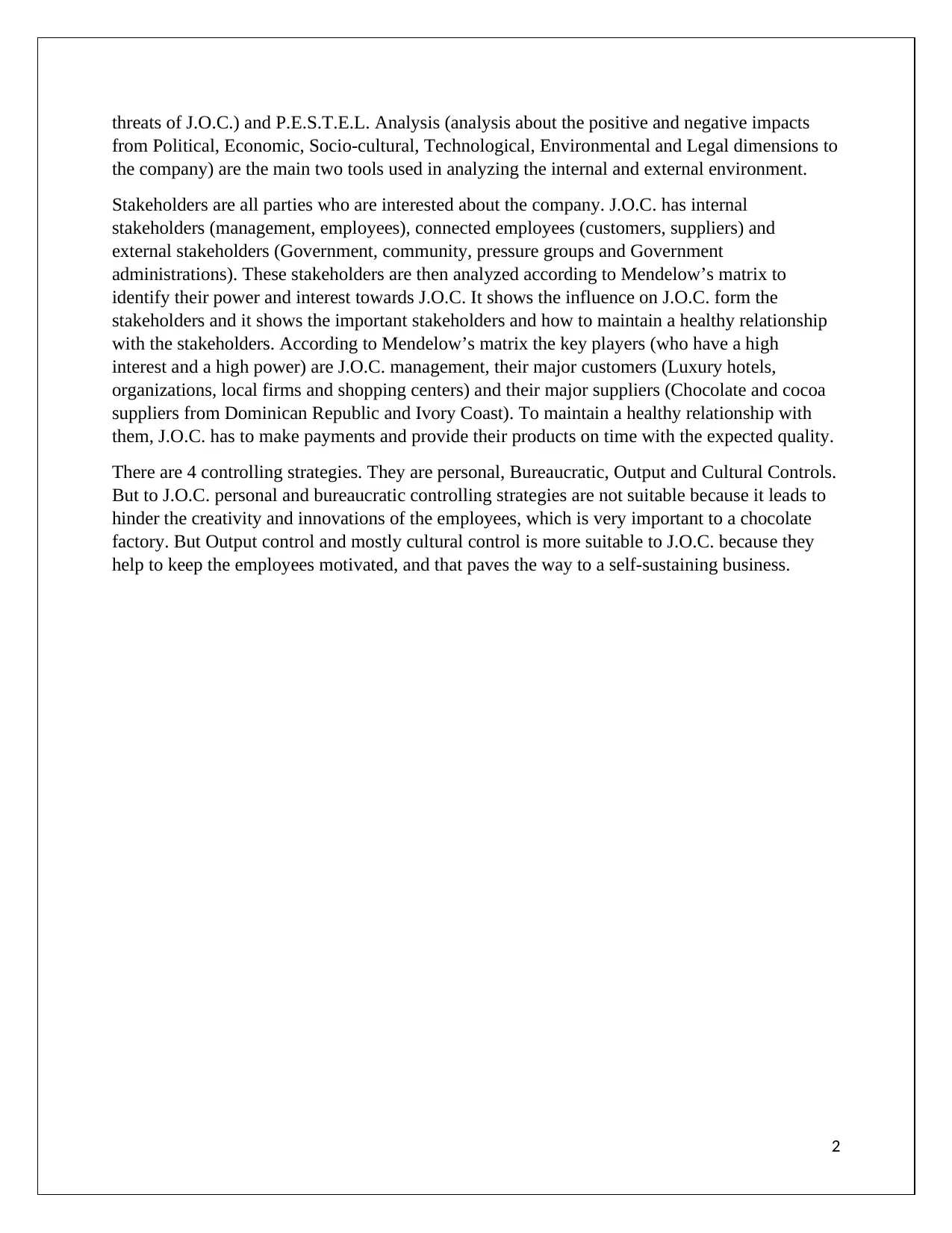
2
threats of J.O.C.) and P.E.S.T.E.L. Analysis (analysis about the positive and negative impacts
from Political, Economic, Socio-cultural, Technological, Environmental and Legal dimensions to
the company) are the main two tools used in analyzing the internal and external environment.
Stakeholders are all parties who are interested about the company. J.O.C. has internal
stakeholders (management, employees), connected employees (customers, suppliers) and
external stakeholders (Government, community, pressure groups and Government
administrations). These stakeholders are then analyzed according to Mendelow’s matrix to
identify their power and interest towards J.O.C. It shows the influence on J.O.C. form the
stakeholders and it shows the important stakeholders and how to maintain a healthy relationship
with the stakeholders. According to Mendelow’s matrix the key players (who have a high
interest and a high power) are J.O.C. management, their major customers (Luxury hotels,
organizations, local firms and shopping centers) and their major suppliers (Chocolate and cocoa
suppliers from Dominican Republic and Ivory Coast). To maintain a healthy relationship with
them, J.O.C. has to make payments and provide their products on time with the expected quality.
There are 4 controlling strategies. They are personal, Bureaucratic, Output and Cultural Controls.
But to J.O.C. personal and bureaucratic controlling strategies are not suitable because it leads to
hinder the creativity and innovations of the employees, which is very important to a chocolate
factory. But Output control and mostly cultural control is more suitable to J.O.C. because they
help to keep the employees motivated, and that paves the way to a self-sustaining business.
threats of J.O.C.) and P.E.S.T.E.L. Analysis (analysis about the positive and negative impacts
from Political, Economic, Socio-cultural, Technological, Environmental and Legal dimensions to
the company) are the main two tools used in analyzing the internal and external environment.
Stakeholders are all parties who are interested about the company. J.O.C. has internal
stakeholders (management, employees), connected employees (customers, suppliers) and
external stakeholders (Government, community, pressure groups and Government
administrations). These stakeholders are then analyzed according to Mendelow’s matrix to
identify their power and interest towards J.O.C. It shows the influence on J.O.C. form the
stakeholders and it shows the important stakeholders and how to maintain a healthy relationship
with the stakeholders. According to Mendelow’s matrix the key players (who have a high
interest and a high power) are J.O.C. management, their major customers (Luxury hotels,
organizations, local firms and shopping centers) and their major suppliers (Chocolate and cocoa
suppliers from Dominican Republic and Ivory Coast). To maintain a healthy relationship with
them, J.O.C. has to make payments and provide their products on time with the expected quality.
There are 4 controlling strategies. They are personal, Bureaucratic, Output and Cultural Controls.
But to J.O.C. personal and bureaucratic controlling strategies are not suitable because it leads to
hinder the creativity and innovations of the employees, which is very important to a chocolate
factory. But Output control and mostly cultural control is more suitable to J.O.C. because they
help to keep the employees motivated, and that paves the way to a self-sustaining business.
⊘ This is a preview!⊘
Do you want full access?
Subscribe today to unlock all pages.

Trusted by 1+ million students worldwide
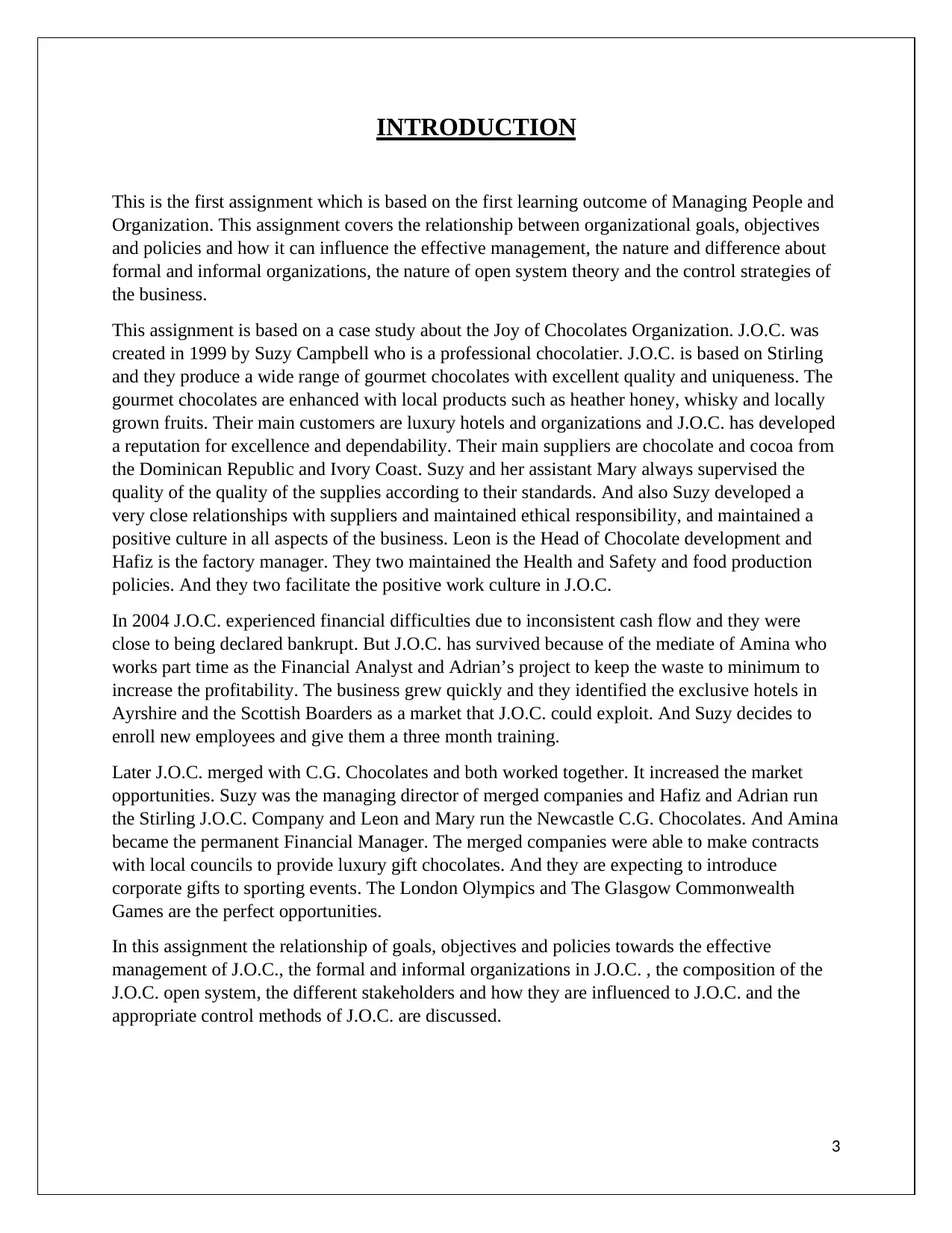
3
INTRODUCTION
This is the first assignment which is based on the first learning outcome of Managing People and
Organization. This assignment covers the relationship between organizational goals, objectives
and policies and how it can influence the effective management, the nature and difference about
formal and informal organizations, the nature of open system theory and the control strategies of
the business.
This assignment is based on a case study about the Joy of Chocolates Organization. J.O.C. was
created in 1999 by Suzy Campbell who is a professional chocolatier. J.O.C. is based on Stirling
and they produce a wide range of gourmet chocolates with excellent quality and uniqueness. The
gourmet chocolates are enhanced with local products such as heather honey, whisky and locally
grown fruits. Their main customers are luxury hotels and organizations and J.O.C. has developed
a reputation for excellence and dependability. Their main suppliers are chocolate and cocoa from
the Dominican Republic and Ivory Coast. Suzy and her assistant Mary always supervised the
quality of the quality of the supplies according to their standards. And also Suzy developed a
very close relationships with suppliers and maintained ethical responsibility, and maintained a
positive culture in all aspects of the business. Leon is the Head of Chocolate development and
Hafiz is the factory manager. They two maintained the Health and Safety and food production
policies. And they two facilitate the positive work culture in J.O.C.
In 2004 J.O.C. experienced financial difficulties due to inconsistent cash flow and they were
close to being declared bankrupt. But J.O.C. has survived because of the mediate of Amina who
works part time as the Financial Analyst and Adrian’s project to keep the waste to minimum to
increase the profitability. The business grew quickly and they identified the exclusive hotels in
Ayrshire and the Scottish Boarders as a market that J.O.C. could exploit. And Suzy decides to
enroll new employees and give them a three month training.
Later J.O.C. merged with C.G. Chocolates and both worked together. It increased the market
opportunities. Suzy was the managing director of merged companies and Hafiz and Adrian run
the Stirling J.O.C. Company and Leon and Mary run the Newcastle C.G. Chocolates. And Amina
became the permanent Financial Manager. The merged companies were able to make contracts
with local councils to provide luxury gift chocolates. And they are expecting to introduce
corporate gifts to sporting events. The London Olympics and The Glasgow Commonwealth
Games are the perfect opportunities.
In this assignment the relationship of goals, objectives and policies towards the effective
management of J.O.C., the formal and informal organizations in J.O.C. , the composition of the
J.O.C. open system, the different stakeholders and how they are influenced to J.O.C. and the
appropriate control methods of J.O.C. are discussed.
INTRODUCTION
This is the first assignment which is based on the first learning outcome of Managing People and
Organization. This assignment covers the relationship between organizational goals, objectives
and policies and how it can influence the effective management, the nature and difference about
formal and informal organizations, the nature of open system theory and the control strategies of
the business.
This assignment is based on a case study about the Joy of Chocolates Organization. J.O.C. was
created in 1999 by Suzy Campbell who is a professional chocolatier. J.O.C. is based on Stirling
and they produce a wide range of gourmet chocolates with excellent quality and uniqueness. The
gourmet chocolates are enhanced with local products such as heather honey, whisky and locally
grown fruits. Their main customers are luxury hotels and organizations and J.O.C. has developed
a reputation for excellence and dependability. Their main suppliers are chocolate and cocoa from
the Dominican Republic and Ivory Coast. Suzy and her assistant Mary always supervised the
quality of the quality of the supplies according to their standards. And also Suzy developed a
very close relationships with suppliers and maintained ethical responsibility, and maintained a
positive culture in all aspects of the business. Leon is the Head of Chocolate development and
Hafiz is the factory manager. They two maintained the Health and Safety and food production
policies. And they two facilitate the positive work culture in J.O.C.
In 2004 J.O.C. experienced financial difficulties due to inconsistent cash flow and they were
close to being declared bankrupt. But J.O.C. has survived because of the mediate of Amina who
works part time as the Financial Analyst and Adrian’s project to keep the waste to minimum to
increase the profitability. The business grew quickly and they identified the exclusive hotels in
Ayrshire and the Scottish Boarders as a market that J.O.C. could exploit. And Suzy decides to
enroll new employees and give them a three month training.
Later J.O.C. merged with C.G. Chocolates and both worked together. It increased the market
opportunities. Suzy was the managing director of merged companies and Hafiz and Adrian run
the Stirling J.O.C. Company and Leon and Mary run the Newcastle C.G. Chocolates. And Amina
became the permanent Financial Manager. The merged companies were able to make contracts
with local councils to provide luxury gift chocolates. And they are expecting to introduce
corporate gifts to sporting events. The London Olympics and The Glasgow Commonwealth
Games are the perfect opportunities.
In this assignment the relationship of goals, objectives and policies towards the effective
management of J.O.C., the formal and informal organizations in J.O.C. , the composition of the
J.O.C. open system, the different stakeholders and how they are influenced to J.O.C. and the
appropriate control methods of J.O.C. are discussed.
Paraphrase This Document
Need a fresh take? Get an instant paraphrase of this document with our AI Paraphraser
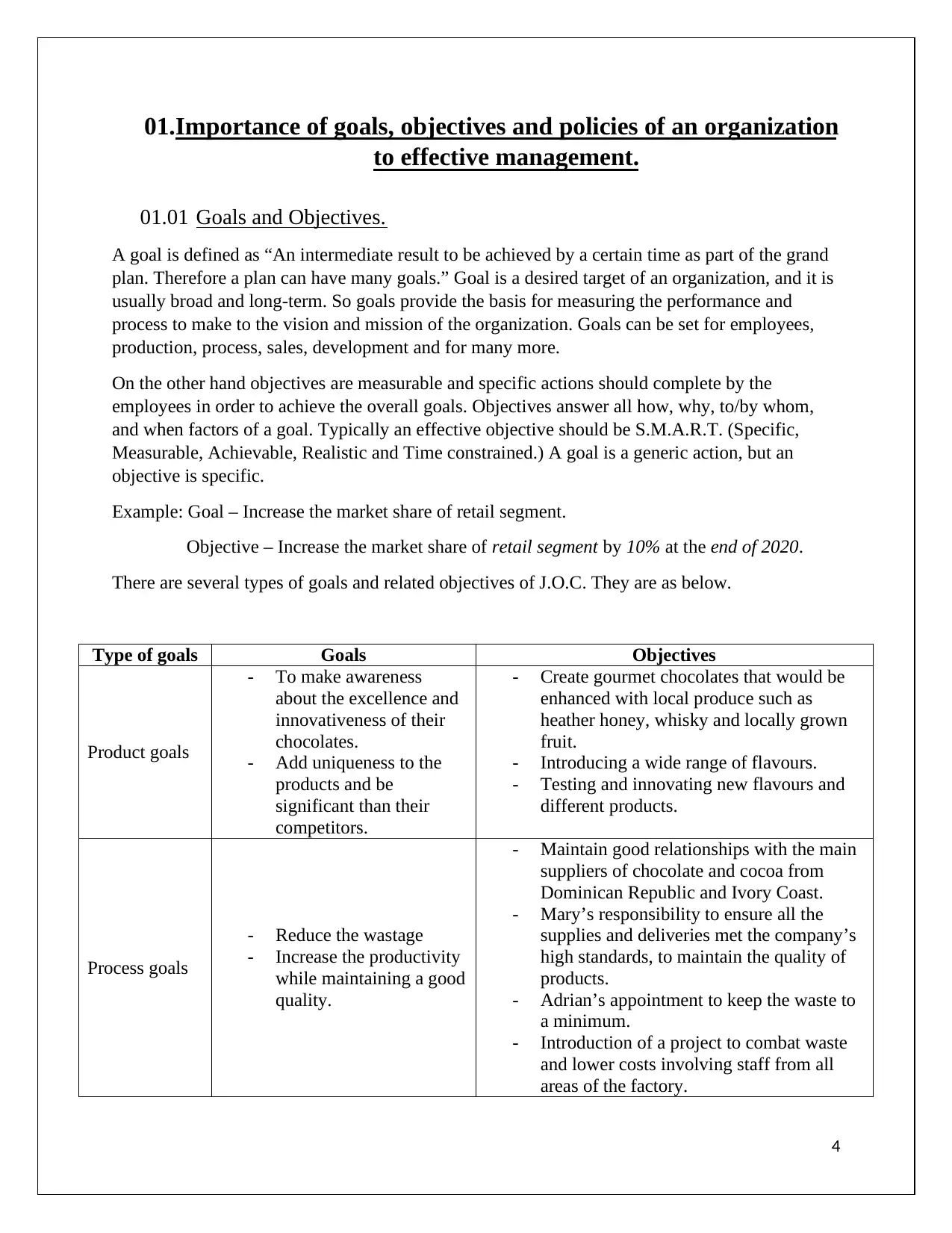
4
01.Importance of goals, objectives and policies of an organization
to effective management.
01.01 Goals and Objectives.
A goal is defined as “An intermediate result to be achieved by a certain time as part of the grand
plan. Therefore a plan can have many goals.” Goal is a desired target of an organization, and it is
usually broad and long-term. So goals provide the basis for measuring the performance and
process to make to the vision and mission of the organization. Goals can be set for employees,
production, process, sales, development and for many more.
On the other hand objectives are measurable and specific actions should complete by the
employees in order to achieve the overall goals. Objectives answer all how, why, to/by whom,
and when factors of a goal. Typically an effective objective should be S.M.A.R.T. (Specific,
Measurable, Achievable, Realistic and Time constrained.) A goal is a generic action, but an
objective is specific.
Example: Goal – Increase the market share of retail segment.
Objective – Increase the market share of retail segment by 10% at the end of 2020.
There are several types of goals and related objectives of J.O.C. They are as below.
Type of goals Goals Objectives
Product goals
- To make awareness
about the excellence and
innovativeness of their
chocolates.
- Add uniqueness to the
products and be
significant than their
competitors.
- Create gourmet chocolates that would be
enhanced with local produce such as
heather honey, whisky and locally grown
fruit.
- Introducing a wide range of flavours.
- Testing and innovating new flavours and
different products.
Process goals
- Reduce the wastage
- Increase the productivity
while maintaining a good
quality.
- Maintain good relationships with the main
suppliers of chocolate and cocoa from
Dominican Republic and Ivory Coast.
- Mary’s responsibility to ensure all the
supplies and deliveries met the company’s
high standards, to maintain the quality of
products.
- Adrian’s appointment to keep the waste to
a minimum.
- Introduction of a project to combat waste
and lower costs involving staff from all
areas of the factory.
01.Importance of goals, objectives and policies of an organization
to effective management.
01.01 Goals and Objectives.
A goal is defined as “An intermediate result to be achieved by a certain time as part of the grand
plan. Therefore a plan can have many goals.” Goal is a desired target of an organization, and it is
usually broad and long-term. So goals provide the basis for measuring the performance and
process to make to the vision and mission of the organization. Goals can be set for employees,
production, process, sales, development and for many more.
On the other hand objectives are measurable and specific actions should complete by the
employees in order to achieve the overall goals. Objectives answer all how, why, to/by whom,
and when factors of a goal. Typically an effective objective should be S.M.A.R.T. (Specific,
Measurable, Achievable, Realistic and Time constrained.) A goal is a generic action, but an
objective is specific.
Example: Goal – Increase the market share of retail segment.
Objective – Increase the market share of retail segment by 10% at the end of 2020.
There are several types of goals and related objectives of J.O.C. They are as below.
Type of goals Goals Objectives
Product goals
- To make awareness
about the excellence and
innovativeness of their
chocolates.
- Add uniqueness to the
products and be
significant than their
competitors.
- Create gourmet chocolates that would be
enhanced with local produce such as
heather honey, whisky and locally grown
fruit.
- Introducing a wide range of flavours.
- Testing and innovating new flavours and
different products.
Process goals
- Reduce the wastage
- Increase the productivity
while maintaining a good
quality.
- Maintain good relationships with the main
suppliers of chocolate and cocoa from
Dominican Republic and Ivory Coast.
- Mary’s responsibility to ensure all the
supplies and deliveries met the company’s
high standards, to maintain the quality of
products.
- Adrian’s appointment to keep the waste to
a minimum.
- Introduction of a project to combat waste
and lower costs involving staff from all
areas of the factory.
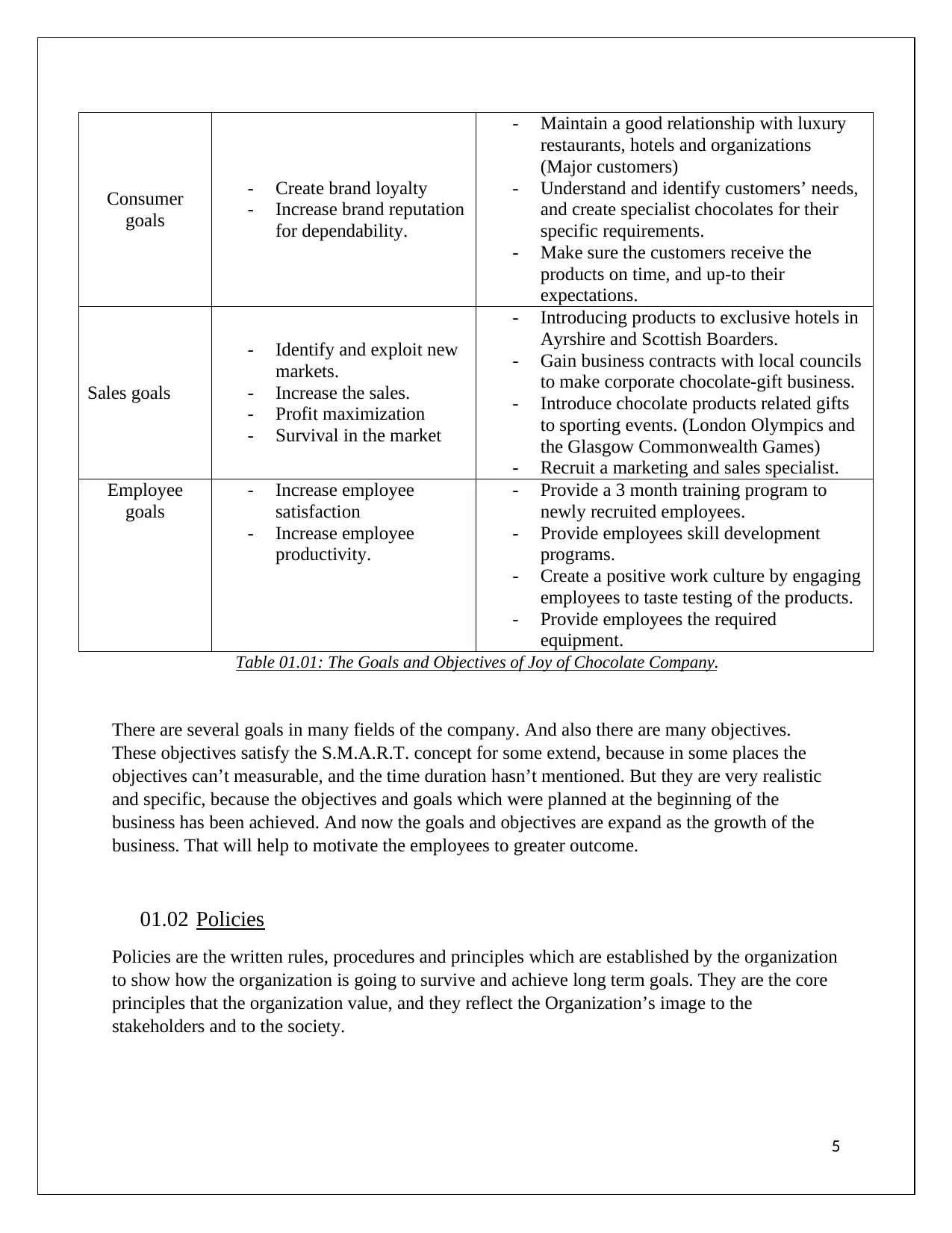
5
Consumer
goals
- Create brand loyalty
- Increase brand reputation
for dependability.
- Maintain a good relationship with luxury
restaurants, hotels and organizations
(Major customers)
- Understand and identify customers’ needs,
and create specialist chocolates for their
specific requirements.
- Make sure the customers receive the
products on time, and up-to their
expectations.
Sales goals
- Identify and exploit new
markets.
- Increase the sales.
- Profit maximization
- Survival in the market
- Introducing products to exclusive hotels in
Ayrshire and Scottish Boarders.
- Gain business contracts with local councils
to make corporate chocolate-gift business.
- Introduce chocolate products related gifts
to sporting events. (London Olympics and
the Glasgow Commonwealth Games)
- Recruit a marketing and sales specialist.
Employee
goals
- Increase employee
satisfaction
- Increase employee
productivity.
- Provide a 3 month training program to
newly recruited employees.
- Provide employees skill development
programs.
- Create a positive work culture by engaging
employees to taste testing of the products.
- Provide employees the required
equipment.
Table 01.01: The Goals and Objectives of Joy of Chocolate Company.
There are several goals in many fields of the company. And also there are many objectives.
These objectives satisfy the S.M.A.R.T. concept for some extend, because in some places the
objectives can’t measurable, and the time duration hasn’t mentioned. But they are very realistic
and specific, because the objectives and goals which were planned at the beginning of the
business has been achieved. And now the goals and objectives are expand as the growth of the
business. That will help to motivate the employees to greater outcome.
01.02 Policies
Policies are the written rules, procedures and principles which are established by the organization
to show how the organization is going to survive and achieve long term goals. They are the core
principles that the organization value, and they reflect the Organization’s image to the
stakeholders and to the society.
Consumer
goals
- Create brand loyalty
- Increase brand reputation
for dependability.
- Maintain a good relationship with luxury
restaurants, hotels and organizations
(Major customers)
- Understand and identify customers’ needs,
and create specialist chocolates for their
specific requirements.
- Make sure the customers receive the
products on time, and up-to their
expectations.
Sales goals
- Identify and exploit new
markets.
- Increase the sales.
- Profit maximization
- Survival in the market
- Introducing products to exclusive hotels in
Ayrshire and Scottish Boarders.
- Gain business contracts with local councils
to make corporate chocolate-gift business.
- Introduce chocolate products related gifts
to sporting events. (London Olympics and
the Glasgow Commonwealth Games)
- Recruit a marketing and sales specialist.
Employee
goals
- Increase employee
satisfaction
- Increase employee
productivity.
- Provide a 3 month training program to
newly recruited employees.
- Provide employees skill development
programs.
- Create a positive work culture by engaging
employees to taste testing of the products.
- Provide employees the required
equipment.
Table 01.01: The Goals and Objectives of Joy of Chocolate Company.
There are several goals in many fields of the company. And also there are many objectives.
These objectives satisfy the S.M.A.R.T. concept for some extend, because in some places the
objectives can’t measurable, and the time duration hasn’t mentioned. But they are very realistic
and specific, because the objectives and goals which were planned at the beginning of the
business has been achieved. And now the goals and objectives are expand as the growth of the
business. That will help to motivate the employees to greater outcome.
01.02 Policies
Policies are the written rules, procedures and principles which are established by the organization
to show how the organization is going to survive and achieve long term goals. They are the core
principles that the organization value, and they reflect the Organization’s image to the
stakeholders and to the society.
⊘ This is a preview!⊘
Do you want full access?
Subscribe today to unlock all pages.

Trusted by 1+ million students worldwide
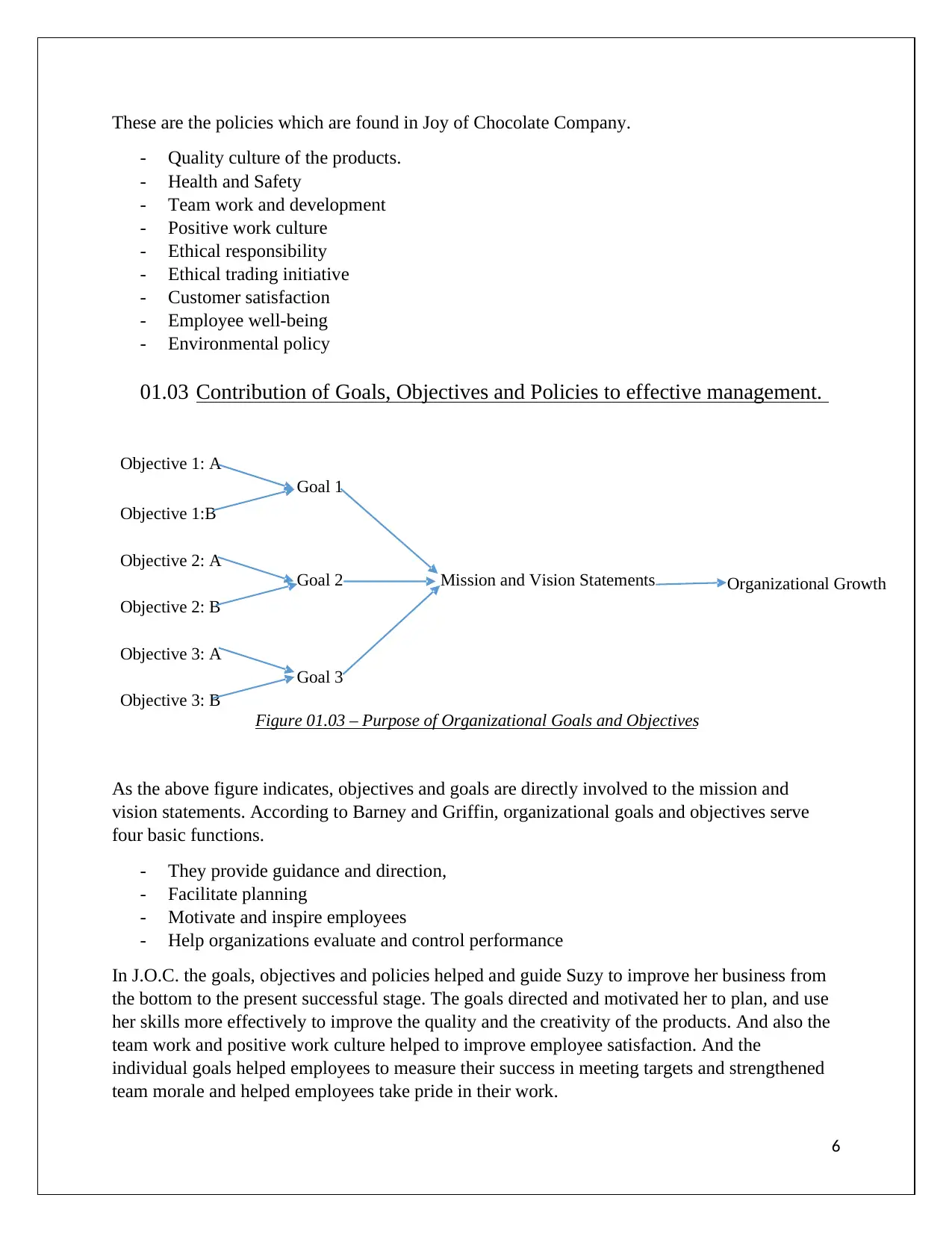
6
These are the policies which are found in Joy of Chocolate Company.
- Quality culture of the products.
- Health and Safety
- Team work and development
- Positive work culture
- Ethical responsibility
- Ethical trading initiative
- Customer satisfaction
- Employee well-being
- Environmental policy
01.03 Contribution of Goals, Objectives and Policies to effective management.
Objective 1: A
Goal 1
Objective 1:B
Objective 2: A
Goal 2 Mission and Vision Statements Organizational Growth
Objective 2: B
Objective 3: A
Goal 3
Objective 3: B
Figure 01.03 – Purpose of Organizational Goals and Objectives
As the above figure indicates, objectives and goals are directly involved to the mission and
vision statements. According to Barney and Griffin, organizational goals and objectives serve
four basic functions.
- They provide guidance and direction,
- Facilitate planning
- Motivate and inspire employees
- Help organizations evaluate and control performance
In J.O.C. the goals, objectives and policies helped and guide Suzy to improve her business from
the bottom to the present successful stage. The goals directed and motivated her to plan, and use
her skills more effectively to improve the quality and the creativity of the products. And also the
team work and positive work culture helped to improve employee satisfaction. And the
individual goals helped employees to measure their success in meeting targets and strengthened
team morale and helped employees take pride in their work.
These are the policies which are found in Joy of Chocolate Company.
- Quality culture of the products.
- Health and Safety
- Team work and development
- Positive work culture
- Ethical responsibility
- Ethical trading initiative
- Customer satisfaction
- Employee well-being
- Environmental policy
01.03 Contribution of Goals, Objectives and Policies to effective management.
Objective 1: A
Goal 1
Objective 1:B
Objective 2: A
Goal 2 Mission and Vision Statements Organizational Growth
Objective 2: B
Objective 3: A
Goal 3
Objective 3: B
Figure 01.03 – Purpose of Organizational Goals and Objectives
As the above figure indicates, objectives and goals are directly involved to the mission and
vision statements. According to Barney and Griffin, organizational goals and objectives serve
four basic functions.
- They provide guidance and direction,
- Facilitate planning
- Motivate and inspire employees
- Help organizations evaluate and control performance
In J.O.C. the goals, objectives and policies helped and guide Suzy to improve her business from
the bottom to the present successful stage. The goals directed and motivated her to plan, and use
her skills more effectively to improve the quality and the creativity of the products. And also the
team work and positive work culture helped to improve employee satisfaction. And the
individual goals helped employees to measure their success in meeting targets and strengthened
team morale and helped employees take pride in their work.
Paraphrase This Document
Need a fresh take? Get an instant paraphrase of this document with our AI Paraphraser
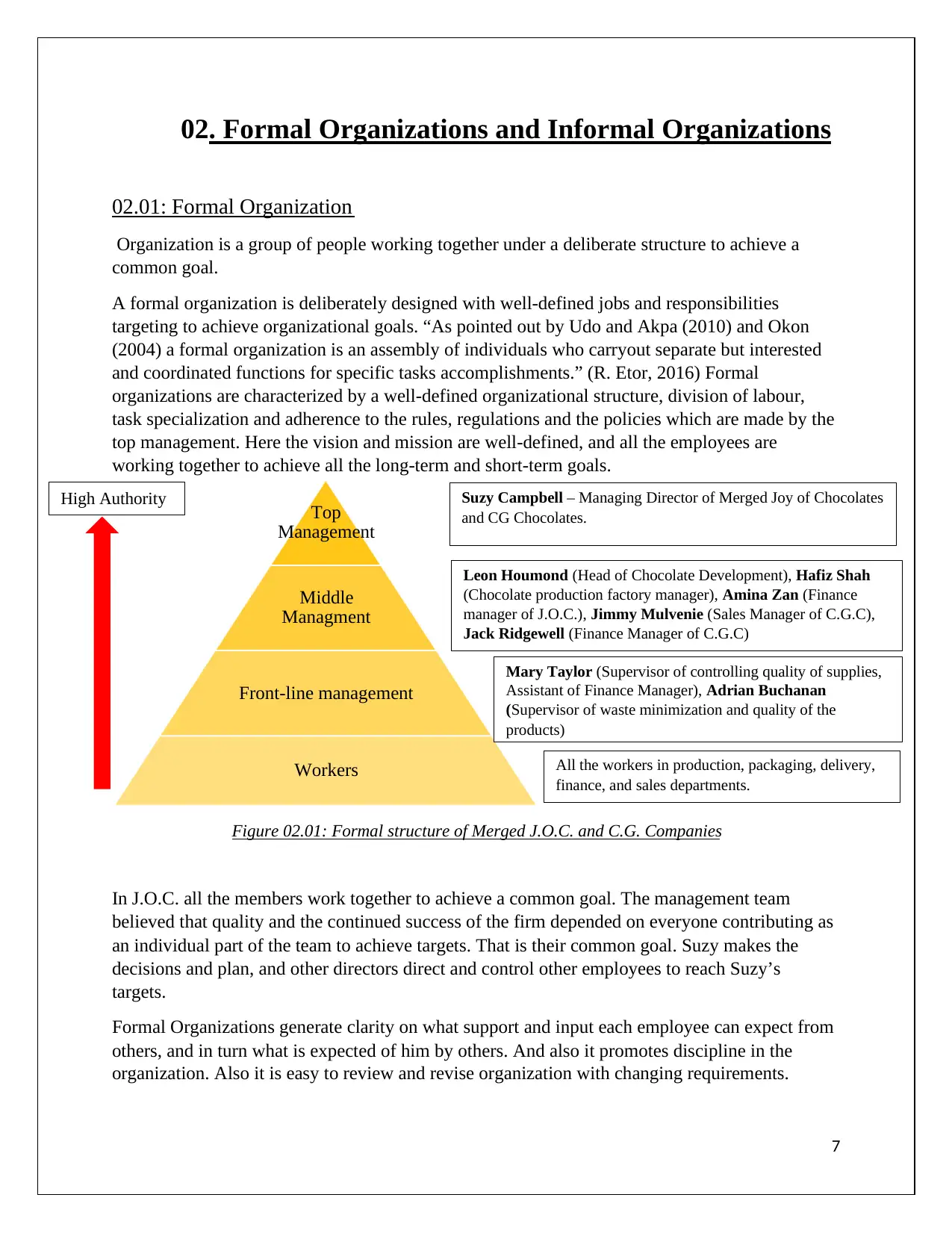
7
02. Formal Organizations and Informal Organizations
02.01: Formal Organization
Organization is a group of people working together under a deliberate structure to achieve a
common goal.
A formal organization is deliberately designed with well-defined jobs and responsibilities
targeting to achieve organizational goals. “As pointed out by Udo and Akpa (2010) and Okon
(2004) a formal organization is an assembly of individuals who carryout separate but interested
and coordinated functions for specific tasks accomplishments.” (R. Etor, 2016) Formal
organizations are characterized by a well-defined organizational structure, division of labour,
task specialization and adherence to the rules, regulations and the policies which are made by the
top management. Here the vision and mission are well-defined, and all the employees are
working together to achieve all the long-term and short-term goals.
Figure 02.01: Formal structure of Merged J.O.C. and C.G. Companies
In J.O.C. all the members work together to achieve a common goal. The management team
believed that quality and the continued success of the firm depended on everyone contributing as
an individual part of the team to achieve targets. That is their common goal. Suzy makes the
decisions and plan, and other directors direct and control other employees to reach Suzy’s
targets.
Formal Organizations generate clarity on what support and input each employee can expect from
others, and in turn what is expected of him by others. And also it promotes discipline in the
organization. Also it is easy to review and revise organization with changing requirements.
Top
Management
Middle
Managment
Front-line management
Workers
Suzy Campbell – Managing Director of Merged Joy of Chocolates
and CG Chocolates.
Leon Houmond (Head of Chocolate Development), Hafiz Shah
(Chocolate production factory manager), Amina Zan (Finance
manager of J.O.C.), Jimmy Mulvenie (Sales Manager of C.G.C),
Jack Ridgewell (Finance Manager of C.G.C)
All the workers in production, packaging, delivery,
finance, and sales departments.
Mary Taylor (Supervisor of controlling quality of supplies,
Assistant of Finance Manager), Adrian Buchanan
(Supervisor of waste minimization and quality of the
products)
High Authority
02. Formal Organizations and Informal Organizations
02.01: Formal Organization
Organization is a group of people working together under a deliberate structure to achieve a
common goal.
A formal organization is deliberately designed with well-defined jobs and responsibilities
targeting to achieve organizational goals. “As pointed out by Udo and Akpa (2010) and Okon
(2004) a formal organization is an assembly of individuals who carryout separate but interested
and coordinated functions for specific tasks accomplishments.” (R. Etor, 2016) Formal
organizations are characterized by a well-defined organizational structure, division of labour,
task specialization and adherence to the rules, regulations and the policies which are made by the
top management. Here the vision and mission are well-defined, and all the employees are
working together to achieve all the long-term and short-term goals.
Figure 02.01: Formal structure of Merged J.O.C. and C.G. Companies
In J.O.C. all the members work together to achieve a common goal. The management team
believed that quality and the continued success of the firm depended on everyone contributing as
an individual part of the team to achieve targets. That is their common goal. Suzy makes the
decisions and plan, and other directors direct and control other employees to reach Suzy’s
targets.
Formal Organizations generate clarity on what support and input each employee can expect from
others, and in turn what is expected of him by others. And also it promotes discipline in the
organization. Also it is easy to review and revise organization with changing requirements.
Top
Management
Middle
Managment
Front-line management
Workers
Suzy Campbell – Managing Director of Merged Joy of Chocolates
and CG Chocolates.
Leon Houmond (Head of Chocolate Development), Hafiz Shah
(Chocolate production factory manager), Amina Zan (Finance
manager of J.O.C.), Jimmy Mulvenie (Sales Manager of C.G.C),
Jack Ridgewell (Finance Manager of C.G.C)
All the workers in production, packaging, delivery,
finance, and sales departments.
Mary Taylor (Supervisor of controlling quality of supplies,
Assistant of Finance Manager), Adrian Buchanan
(Supervisor of waste minimization and quality of the
products)
High Authority
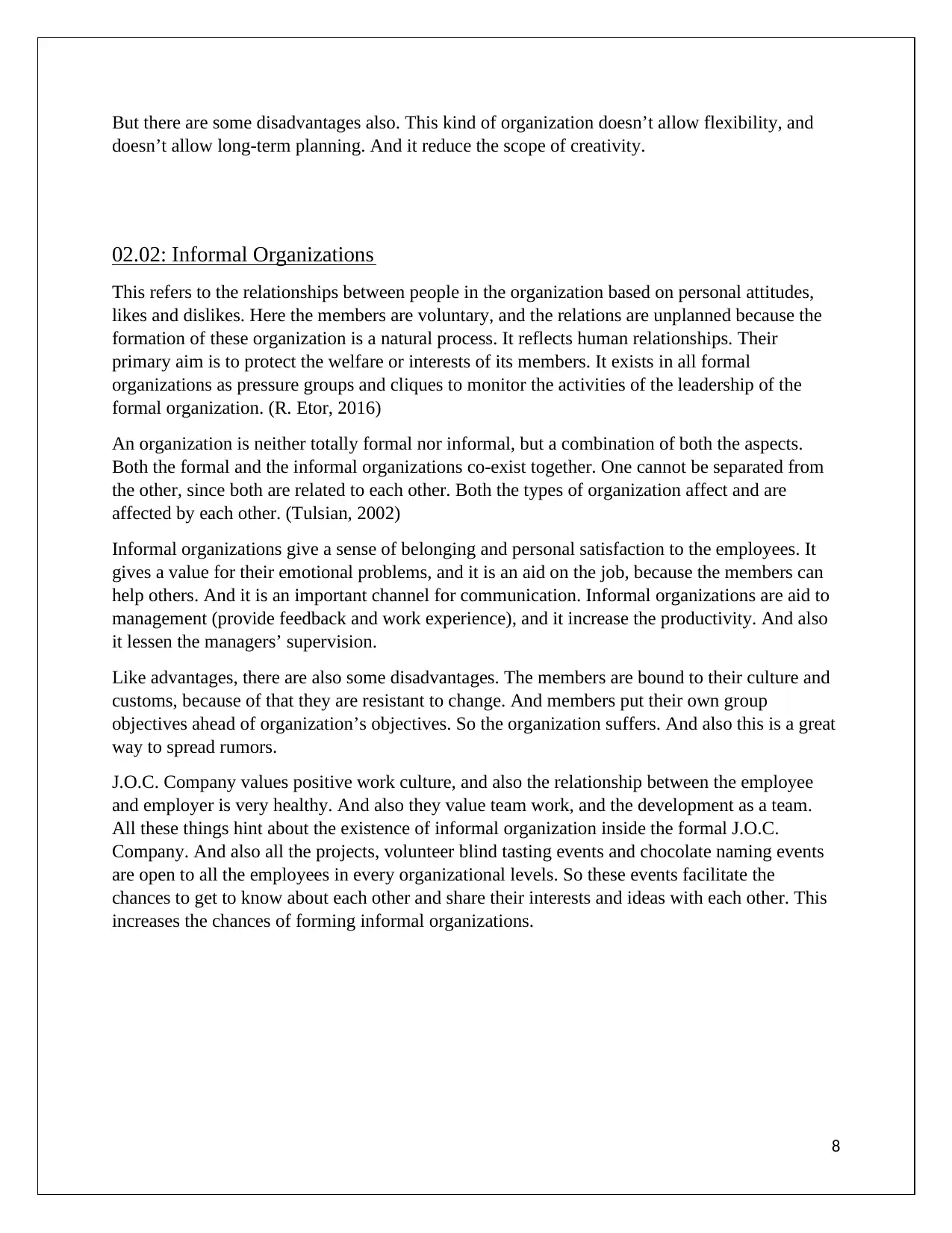
8
But there are some disadvantages also. This kind of organization doesn’t allow flexibility, and
doesn’t allow long-term planning. And it reduce the scope of creativity.
02.02: Informal Organizations
This refers to the relationships between people in the organization based on personal attitudes,
likes and dislikes. Here the members are voluntary, and the relations are unplanned because the
formation of these organization is a natural process. It reflects human relationships. Their
primary aim is to protect the welfare or interests of its members. It exists in all formal
organizations as pressure groups and cliques to monitor the activities of the leadership of the
formal organization. (R. Etor, 2016)
An organization is neither totally formal nor informal, but a combination of both the aspects.
Both the formal and the informal organizations co-exist together. One cannot be separated from
the other, since both are related to each other. Both the types of organization affect and are
affected by each other. (Tulsian, 2002)
Informal organizations give a sense of belonging and personal satisfaction to the employees. It
gives a value for their emotional problems, and it is an aid on the job, because the members can
help others. And it is an important channel for communication. Informal organizations are aid to
management (provide feedback and work experience), and it increase the productivity. And also
it lessen the managers’ supervision.
Like advantages, there are also some disadvantages. The members are bound to their culture and
customs, because of that they are resistant to change. And members put their own group
objectives ahead of organization’s objectives. So the organization suffers. And also this is a great
way to spread rumors.
J.O.C. Company values positive work culture, and also the relationship between the employee
and employer is very healthy. And also they value team work, and the development as a team.
All these things hint about the existence of informal organization inside the formal J.O.C.
Company. And also all the projects, volunteer blind tasting events and chocolate naming events
are open to all the employees in every organizational levels. So these events facilitate the
chances to get to know about each other and share their interests and ideas with each other. This
increases the chances of forming informal organizations.
But there are some disadvantages also. This kind of organization doesn’t allow flexibility, and
doesn’t allow long-term planning. And it reduce the scope of creativity.
02.02: Informal Organizations
This refers to the relationships between people in the organization based on personal attitudes,
likes and dislikes. Here the members are voluntary, and the relations are unplanned because the
formation of these organization is a natural process. It reflects human relationships. Their
primary aim is to protect the welfare or interests of its members. It exists in all formal
organizations as pressure groups and cliques to monitor the activities of the leadership of the
formal organization. (R. Etor, 2016)
An organization is neither totally formal nor informal, but a combination of both the aspects.
Both the formal and the informal organizations co-exist together. One cannot be separated from
the other, since both are related to each other. Both the types of organization affect and are
affected by each other. (Tulsian, 2002)
Informal organizations give a sense of belonging and personal satisfaction to the employees. It
gives a value for their emotional problems, and it is an aid on the job, because the members can
help others. And it is an important channel for communication. Informal organizations are aid to
management (provide feedback and work experience), and it increase the productivity. And also
it lessen the managers’ supervision.
Like advantages, there are also some disadvantages. The members are bound to their culture and
customs, because of that they are resistant to change. And members put their own group
objectives ahead of organization’s objectives. So the organization suffers. And also this is a great
way to spread rumors.
J.O.C. Company values positive work culture, and also the relationship between the employee
and employer is very healthy. And also they value team work, and the development as a team.
All these things hint about the existence of informal organization inside the formal J.O.C.
Company. And also all the projects, volunteer blind tasting events and chocolate naming events
are open to all the employees in every organizational levels. So these events facilitate the
chances to get to know about each other and share their interests and ideas with each other. This
increases the chances of forming informal organizations.
⊘ This is a preview!⊘
Do you want full access?
Subscribe today to unlock all pages.

Trusted by 1+ million students worldwide
1 out of 27
Related Documents
Your All-in-One AI-Powered Toolkit for Academic Success.
+13062052269
info@desklib.com
Available 24*7 on WhatsApp / Email
![[object Object]](/_next/static/media/star-bottom.7253800d.svg)
Unlock your academic potential
Copyright © 2020–2025 A2Z Services. All Rights Reserved. Developed and managed by ZUCOL.





